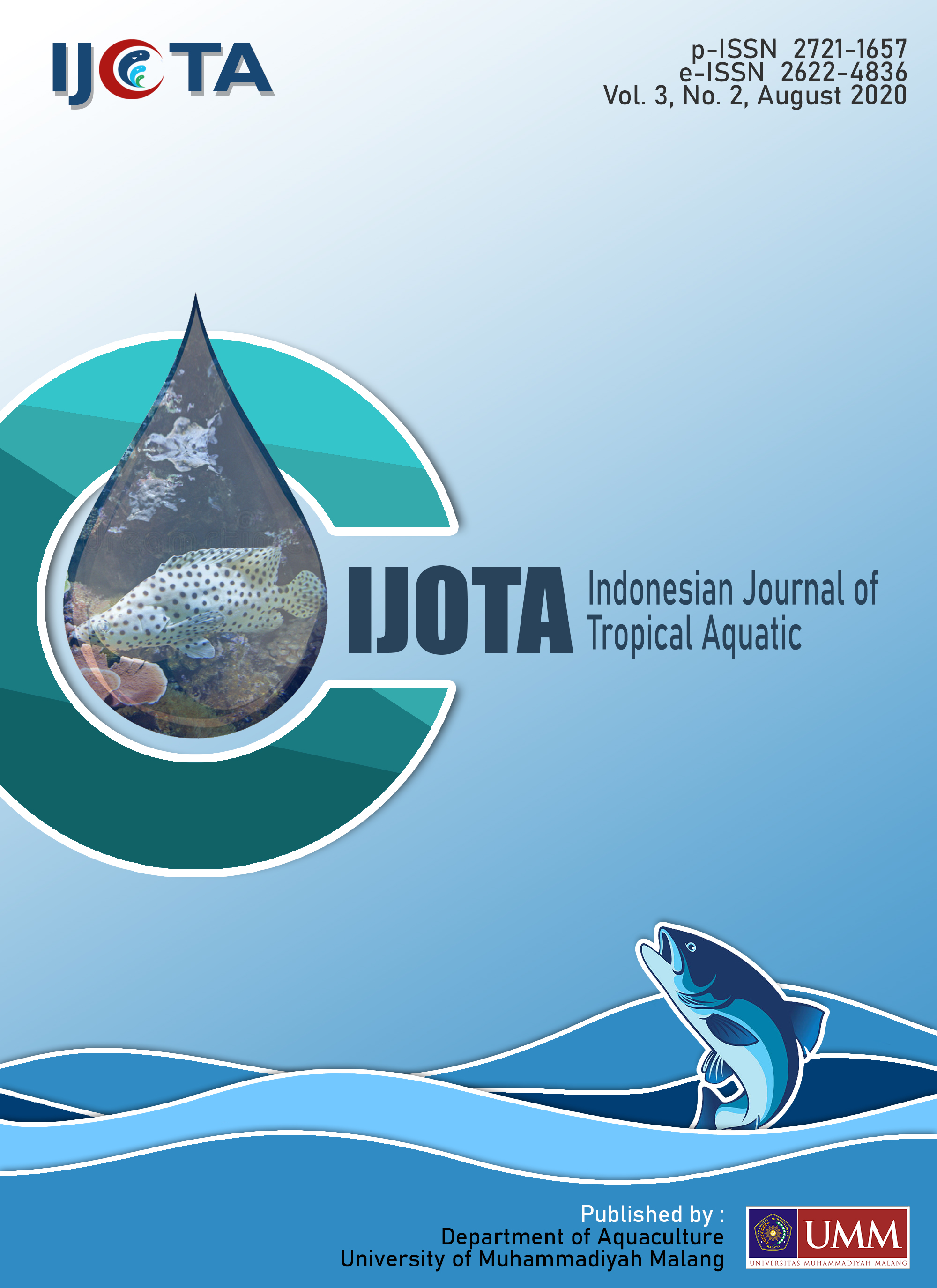The relationship of redox potential to crustacea abundance at Bama beach of Baluran National Park, Situbondo, Indonesia
DOI:
https://doi.org/10.22219/ijota.v3i2.13204Keywords:
Crustaceans, Mangroves, Redox Potential, SedimentAbstract
Catfish farming is growing rapidly because the cultivation and marketing technology is relatively easy for the community to master, and the required business capital is relatively small. Pond water waste originating from fish metabolism and dissolved food waste is toxic to fish. One of the efforts that can be done is fish farming that is integrated with plants through an aquaponics system. Research to determine the effect of AB Mix addition on the growth of African catfish and lettuce cultivated by the aquaponics system. The research method used was an experimental method with a completely randomized design (CRD) consisting of three treatments and three replications. The addition of AB mixed nutrition did not differ in the growing significance of catfish and lettuce. However, the increase in growth occurred with an increasing dosage of AB mix with the best treatment with AB Mix 3 mL L-1. This treatment resulted in absolute growth in fish of 20.52 g and 4.62 g of watercress. The use of a dosage of AB mix higher than 3 mL L-1 may result in better growth.
Downloads
References
Adams CR, Bamford KM, & Early MP. 2008. Priciples of horticulture (5th ed). pp. 57.
Agus. 2011. Assessment of Water Quality and Potential Situ Situ Study As Water Tourism University of Indonesia, Depok. FMIPA. UI
Amalia CD, Hasan Z, & Mulyani Y. 2012. Plankton Community Spatial Distribution as Aquatic Quality Indicator in Situ Bagendit, Banyuresmi District, Garut Regency, West Java Province. Journal of Fisheries and Maritime Affairs. 3(4): 301–311.
Djoko. 2006. Sangkuriang Catfish Alternative Quality in the Land of Priangan. Trobos Jakarta. August: 80 - 81.
Dobermenn A & Fairhurst T. 2000. Rice: Nutrient Disorber And Nutrient Management. International Rice Research Institude-Potash and Phospate Institude (PPI) - potash
Effendi H. 2003. Analysis of Water Quality for Water Resources and Environmental Management. Kanisius. Jakarta.
Estriyani A. 2013. Effect of Addition of Turmeric Solution (Curcuma longa) on Feed Against Growth of Dumbo Catfish (Clarias gariepinus). thesis. Now: IKIP PGRI Semarang.
Hidayat D, Ade DS, & Yulisma. 2013. Survival, growth and fish feed efficiency cork (Channa striata) which is given food made from bakutepung golden snail (Pomacea sp). Indonesian swamp aquaculture journal. 1(2): 161–172
Himawan. 2008. Cultivation of Sangku-merry Catfish. http://IndonesiaIndonesia.com/f/18253-budidaya-lele-sangkuriang-clarias-sp/. 11:30 p.m. June 23, 2012 in Agriculture, New Yourk: CAB International, 1997. (accessed 15 April 2018) 1: 1 column.
Kordi MG & Tanjung AB. 2007. Management of Water Quality in Aquaculture. Rineka Cipta. Jakarta
Lawalata IJ. 2011. Provision of Several ZPT for Regeneration of Gloxinia (Siningia speciosa) Plants from Stem and Leaf Explants in Vitro. J. Exp. Life. 4(2): 83–94.
Maniagasi R, Tumembouw SS, & Mundeng Y. 2013. Analysis of the quality of water physics chemistry in the Lake Tondano fish farming area of North Sulawesi Province. Aquaculture, 1 (2): 29-37.
Nugroho RA, Pambudi LT, & Haditomo AHC. 2012. Aquaponics technology application in freshwater fish farming to optimize production capacity. Science and Technology Journal of Fisheries.
Ogunji JO, Kloas W, Wirth M, Schulz C, & Renert B. 2008. Housefly maggot meal (protein) as a protein source for Oreochromis niloticus (Linn.). Asian Fisheries Science.
Supriyanto. 2010. The effect of giving probiotics in pellets on the growth of Sangkuriang catfish. Semarang State University.
Saputra HM. 2013. Histological Structure of Gills and Hemoglobin Levels of Asang Fish (Osteochilus hasseltii CV) at Singkarak and Maninjau Lake, West Sumatra. Padang: Andalas University Biology Journal
Syahid M, Subhan A, & Armando R. 2006. Polyculture of Organic Milkfish Cultivation. Self-help Spreaders. Jakarta. pp. 64.Downloads
Published
How to Cite
Issue
Section
License
Copyright (c) 2020 Hariyadi

This work is licensed under a Creative Commons Attribution-ShareAlike 4.0 International License.
IJOTA (Indonesian Journal of Tropical Aquatic) allows readers to read, download, copy, distribute, print, search, or link to its articles' full texts and allows readers to use them for any other lawful purpose. The journal allows the author(s) to hold the copyright without restrictions. Finally, the journal allows the author(s) to retain publishing rights without restrictions
- Authors are allowed to archive their submitted article in an open access repository
- Authors are allowed to archive the final published article in an open access repository with an acknowledgment of its initial publication in this journal


